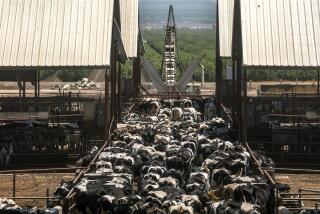WHAT’S FRESH: BUYING OPPORTUNITIES : From the Hive : The honey that bees produce is a popular and marketable commodity that is readily available in the county.
- Share via
Ever wonder what those stacks of white, boxlike structures are that can be seen in so many orchards and fields across Ventura County?
Most likely they’re beehives. And inside, thousands of bees are busily manufacturing that sweet, syrupy substance used for everything from topping on a slice of toast to soothing a sore throat.
While pollination is a chief reason the bee is among a farmer’s best friends, the honey they produce from blossom nectar is a popular and marketable commodity--and available in Ventura County straight from the beehive.
Friend’s Ranch in Ojai handles its own bees and sells honey at its roadside stand.
As explained by Friend’s Ranch Manager Tony Thatcher, the production of honey is quite easy because “the bees do most of the work.”
The bees are provided a wooden boxlike hive already outfitted with sheets of beeswax to expedite the honey-making process.
“Usually 10 wood-framed sheets of beeswax are placed inside the hive and are stamped with a hexagon pattern. The bees will build up from the pattern and construct the tiny cells that make up the honeycomb.
“Each hive houses one queen bee and her sole purpose is to lay eggs in those cells,” Thatcher said, “and the total population of a hive can be 20,000 to 50,000.”
Part of the hive population consists of male drones with a sole purpose of “mating with the queen just once and then just kind of kicking back and eating,” he said.
The Queen’s brood is nourished by a hard-driven, all-female contingent of worker bees that spend their six-week life span gathering nectar from blossoming plants and trees.
“Returning to the hive, they regurgitate the nectar and fill the cells with it,” Thatcher said.
And “it” is what we know to be honey.
“Once they fill the cell with honey--and they will, whether it contains larvae or not--they cap each one,” Thatcher said. “When you’re ready to extract the honey, the top layer of wax from each sheet is sliced off.”
Honey is extracted from the comb by employing a hand-cranked device, creating a centrifugal force, draining the honey into a holding tub. Each framed sheet contains one to two pounds of honey.
“Basically we then filter it and put it in a jar,” he said.
Thatcher said that multileveled hives are used to isolate the larvae, thereby limiting the need for honey filtration, which also removes wax and dirt particles.
“One of the tricks is to keep the larvae in one level and honey in another. If you can keep the queen in the bottom level, she will lay her eggs only in the bottom,” Thatcher said.
To do this, the opening between levels inside the hive is made so the queen is hindered from passing through.
“The queen is three- to five-times bigger than the workers so the hole is made too small to pass through,” Thatcher said.
And does all this human interference deprive the bees of food? Thatcher says no, since the bees are always producing more than they need.
With no rain for the past four years, Thatcher said this has been a bad time for beekeepers whose bees depend on wild flowers for nectar. “With the drought there are far fewer blossoms,” he said. Some beekeepers compensate by supplying bees with sugar water, which produces honey that is less desirable and less flavorful.
The different varieties of honey, such as clover and orange, are simply determined by the type of blossom from which the bees extract nectar, Thatcher said.
“The tastes do differ. The avocado, for instance, is much darker, almost like molasses and stronger tasting than most.
“If you want a particular type, say like almond honey, the bees must be placed in a blossoming almond orchard. You have to extract the honey before moving the hives to another area so there is no mixing of nectars,” Thatcher said.
Given that bees will travel over a mile from the hive, it’s difficult to ensure a pure variety, he said.
Friend’s Ranch offers a sage and orange blossom blend.
“It’s a nice aromatic honey and one of the more popular,” Thatcher said.
The going rate for a pound of honey is about $1.60.
Friend’s Ranch is at 15150 Maricopa Highway, Ojai. Call 646-2871.






